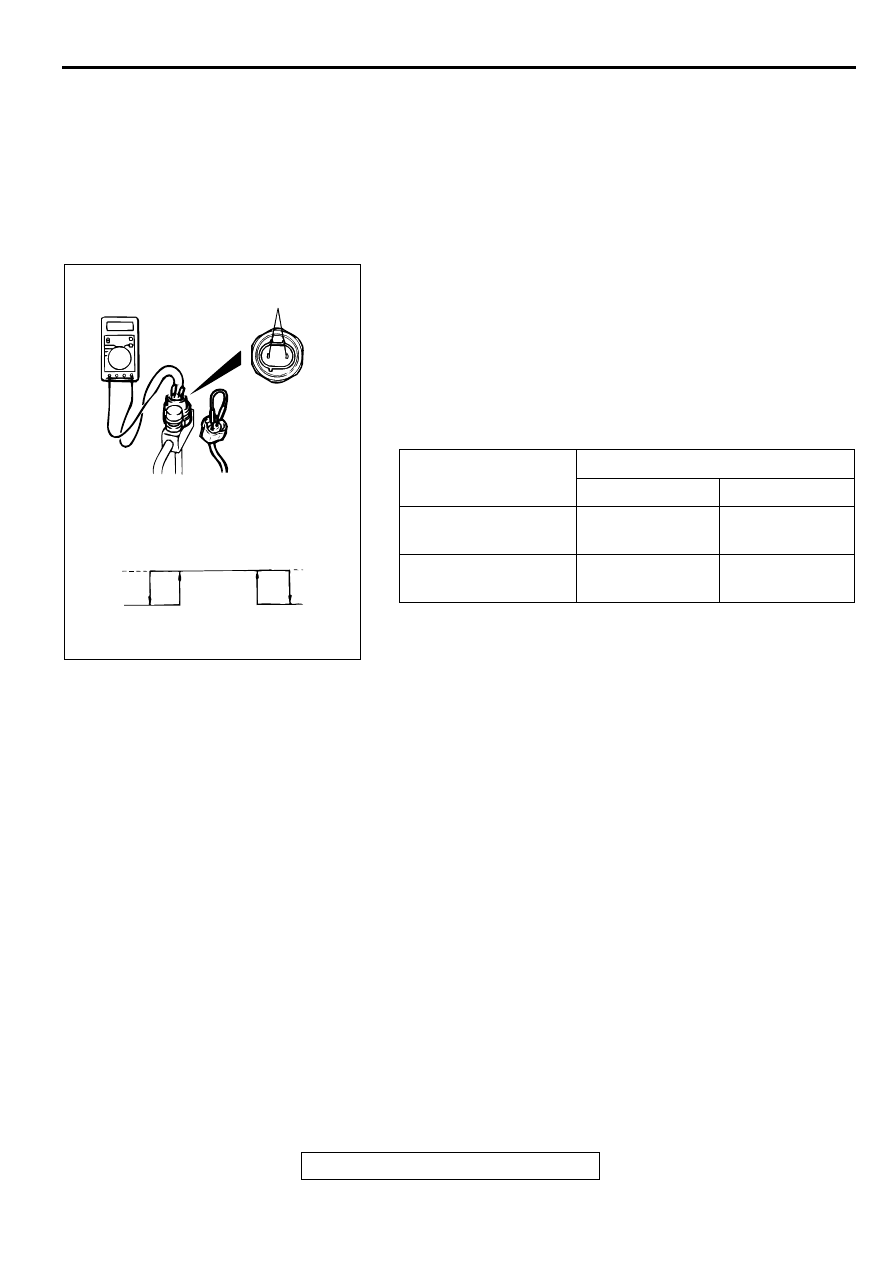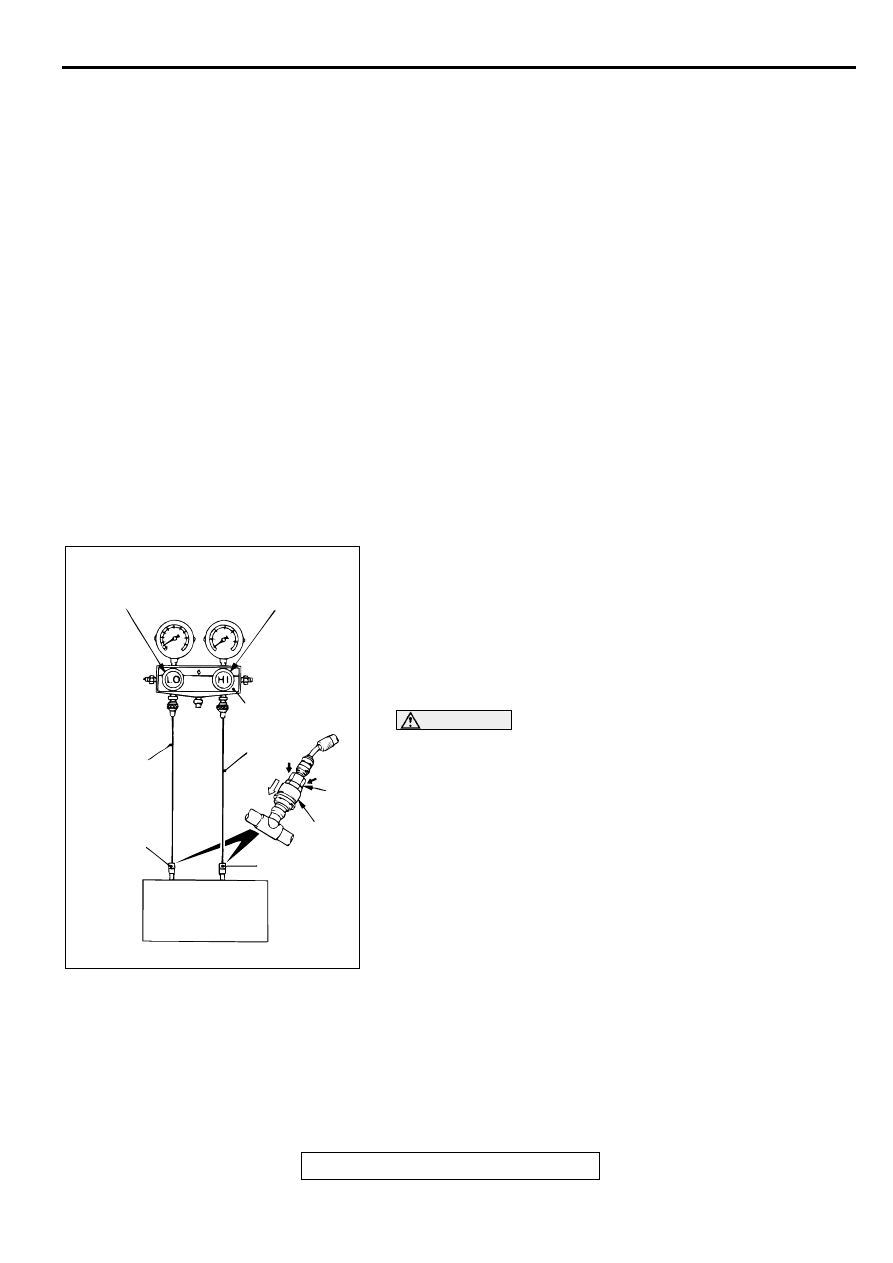Mitsubishi Eclipse / Eclipse Spyder (2000-2002). Service and repair manual — part 696

ON-VEHICLE SERVICE
TSB Revision
HEATING AND AIR CONDITIONING
55-21
RECEIVER DRIER TEST
M1552008600060
Operate the unit and check the piping temperature by touching
the receiver drier outlet and inlet.
If there is a difference in the temperatures, the receiver drier is
restricted.
Replace the receiver drier.
PRESSURE SWITCH CHECK
M1552010400063
1. Remove the dual pressure switch connector and connect
the high/low pressure side terminals located on the harness
side as shown in the illustration.
2. Install a gauge manifold to the high-pressure side service
valve of the refrigerant line. (Refer to
3. When the high/low pressure sides of the dual pressure
switch are at operation pressure (ON) and there is continuity
between the respective terminals, then the condition is
normal. If there is no continuity, replace the switch.
COMPRESSOR DRIVE BELT ADJUSTMENT
M1552001000067
Refer to GROUP 00, Maintenance Service
−
CHARGING
M1552001200072
Use the refrigerant recovery station to charge the refrigerant.
METHOD BY USING REFRIGERANT RECOVERY
AND RECYCLING UNIT
Using the refrigerant recovery and recycling unit, refill the
refrigerant.
NOTE: Refer to that Refrigerant Recovery and Recycling Unit
Instruction Manual for operation of the unit.
DISCHARGING SYSTEM
Use the refrigerant recovery unit to discharge refrigerant gas
from the system.
NOTE: Refer to that Refrigerant Recovery and Recycling Unit
Instruction Manual for operation of the unit.
ITEMS
SWITCH POSITION
OFF
→
ON
ON
→
OFF
Low-pressure side
kPa (psi)
221 (32.1)
196 (28.4)
High-pressure side
kPa (psi)
2,354 (341.4)
2,942 (426.7)
AC001368 AB
HIGH/LOW
PRESSURE SIDE
LOW-PRESSURE
SIDE
HIGH-PRESSURE
SIDE
ON
OFF
ON
OFF

ON-VEHICLE SERVICE
TSB Revision
HEATING AND AIR CONDITIONING
55-22
REFILLING OF OIL IN THE A/C SYSTEM
Too little oil will provide inadequate compressor lubrication and
cause a compressor failure. Too much oil will increase
discharge air temperature.
When a compressor is installed at the factory, it contains 120
cm
3
(4.1 floz) of refrigerant oil. While the A/C system is in
operation, the oil is carried through the entire system by the
refrigerant. Some of this oil will be trapped and retained in
various parts of the system.
When the following system components are changed, it is
necessary to add oil to the system to replace the oil being
removed with the component.
Compressor oil: SUN PAG 56
Quantity:
••••
Evaporator: 60 cm
3
(2.0 floz)
••••
Condenser: 15 cm
3
(0.5 floz)
••••
Suction hose: 10 cm
3
(0.3 floz)
PERFORMANCE TEST
M1552001400065
1. The vehicles to be tested should be in a place that is not in
direct sunlight.
2. Close the high and low-pressure valve of the gauge
manifold.
3. Connect the charging hose (blue) to the low-pressure valve
and connect the charging hose (red) to the high-pressure
valve of the gauge manifold.
4. Install the quick joint (for low-pressure) to the charging hose
(blue), and connect the quick joint (for high-pressure) to the
charging hose (red).
CAUTION
•
To connect the quick joint, press section A firmly
against the service valve until a click is heard.
•
When connecting, run your hand along the hose while
pressing to ensure that there are no bends in the hose.
NOTE: The high-pressure service valve is on A/C pipe and the
low-pressure service valve is on the suction hose.
5. Connect the quick joint (for low-pressure) to the low-
pressure service valve and connect the quick joint (for high-
pressure) to the high-pressure service valve.
6. Start the engine.
7. Set the A/C controls as follows:
•
A/C switch: A/C
−
ON position
•
Mode selection: FACE position
•
Temperature control: MAXIMUM COOLING position
•
Air selection: RECIRCULATION position
•
Blower switch: "4" (Fast) position
8. Adjust engine speed to 1,500 r/min with A/C clutch engaged.
9. Engine should be warmed up with doors and windows
closed.
AC001388
LOW-PRESSURE
VALVE
HIGH-PRESSURE
VALVE
GAUGE MANIFOLD
CHARGING
HOSE (RED)
A
SLEEVE
CHARGING
HOSE (BLUE)
ADAPTOR
VALVE
(FOR
LOW-PRES-
SURE)
ADAPTOR
VALVE
(FOR HIGH-
PRESSURE)
LOW-
PRESSURE
SERVICE
VALVE
HIGH-
PRESSURE
SERVICE
VALVE
AB

ON-VEHICLE SERVICE
TSB Revision
HEATING AND AIR CONDITIONING
55-23
10.Insert a thermometer in the center air outlet and operate the
engine for 20 minutes.
NOTE: If the clutch cycles, take the reading before the clutch
disengages.
11.Note the discharge air temperature.
Performance Temperature Chart
REFRIGERANT LEAK REPAIR PROCEDURE
M1552001500062
LOST CHARGE
If the system has lost all charge due to a leak:
1. Evacuate the system. (Refer to
2. Charge the system with approximately 0.453 kg
(1 pound) of refrigerant.
3. Check for leaks.
4. Discharge the system.
5. Repair leaks.
CAUTION
Replacement filter-drier units must be sealed
while in storage. The drier used in these units
will saturate water quickly upon exposure to the
atmosphere. When installing a drier, have all
tools and supplies ready for quick assembly to
avoid keeping the system open any longer than
necessary.
6. Replace receiver drier.
7. Evacuate and charge system.
LOW CHARGE
If the system has not lost all of its refrigerant charge;
locate and repair all leaks. If it is necessary to
increase the system pressure to find the leak
(because of an especially low charge) add
refrigerant. If it is possible to repair the leak without
discharging the refrigerant system, use the
procedure for correcting low refrigerant level.
HANDLING TUBING AND FITTINGS
Kinks in the refrigerant tubing or sharp bends in the
refrigerant hose lines will greatly reduce the capacity
of the entire system. High pressures are produced in
the system when it is operating. Extreme care must
be exercised to make sure that all connections are
pressure tight. Dirt and moisture can enter the
system when it is opened for repair or replacement of
lines or components. The following precautions must
be observed. The system must be completely
discharged before opening any fitting of connection
in the refrigeration system. Open fittings with caution
even after the system has been discharged. If any
pressure is noticed as a fitting is loosened, allow
trapped pressure to bleed off very slowly.
Never attempt to rebend formed lines to fit. Use the
correct line for the installation you are servicing. A
good rule for the flexible hose lines is keep the radius
of all bends at least 10 times the diameter of the
hose.
Sharper bends will reduce the flow of refrigerant. The
flexible hose lines should be routed so that they are
at least 80 mm (3.1 inches) from the exhaust
manifold. It is good practice to inspect all flexible
hose lines at least once a year to make sure they are
in good condition and properly routed.
On standard plumbing fittings with O-rings, these
O-rings are not reusable.
AC001389
THERMOMETER
AB
GARAGE AMBIENT TEMPERATURE
°
C (
°
F)
20 (68)
25 (77)
35 (95)
40 (104)
Discharge air temperature
°
C (
°
F)
5.0
−
10.0
(42
−
50)
6.0
−
10.5
(43
−
51)
7.5
−
12.0
(46
−
54)
7.5
−
12.5
(46
−
55)
Compressor high pressure kPa (psi)
1,540
−
1,935
(224
−
281)
1,618
−
2,000
(235
−
290)
2,070
−
2,205
(301
−
320)
2,140
−
2,620
(311
−
380)
Compressor low pressure kPa (psi)
125
−
155
(18
−
23)
125
−
155
(18
−
23)
150
−
180
(22
−
26)
145
−
190
(21
−
28)

ON-VEHICLE SERVICE
TSB Revision
HEATING AND AIR CONDITIONING
55-24
COMPRESSOR NOISE CHECK
M1552008700067
You must first know the conditions when the noise
occurs. These conditions are: weather, vehicle
speed, in gear or neutral, engine temperature or any
other special conditions.
Noises that develop during A/C operation can often
be misleading. For example: what sounds like a
failed front bearing or connecting rod, may be
caused by loose bolts, nuts, mounting brackets, or a
loose clutch assembly. Verify accessory drive belt
tension (power steering or generator).
Improper accessory drive belt tension can cause a
misleading noise when the compressor is engaged
and little or no noise when the compressor is
disengaged.
Drive belts are speed-sensitive. That is, at different
engine speeds, and depending upon belt tension,
belts can develop unusual noises that are often
mistaken for mechanical problems within the
compressor.
ADJUSTMENT
1. Select a quiet area for testing. Duplicate
conditions as much as possible. Switch
compressor on and off several times to clearly
identify compressor noise. To duplicate high
ambient conditions (high head pressure), restrict
air flow through condenser. Install manifold gauge
set to make sure discharge pressure doesn't
exceed 2,070 kPa (300.2 psi).
2. Tighten all compressor mounting bolts, clutch
mounting bolt, and compressor drive belt. Check
to assure clutch coil is tight (no rotation or
wobble).
3. Check refrigerant hoses for rubbing or
interference that can cause unusual noises.
4. Check refrigerant charge. (Refer to
5. Recheck compressor noise as in Step 1.
6. If noise still exists, loosen compressor mounting
bolts and retighten. Repeat Step 1.
7. If noise continues, replace compressor and repeat
Step 1.
POWER RELAY CHECK
M1552008800064
BLOWER RELAY
BATTERY
VOLTAGE
TERMINAL NO.
TO BE
CONNECTED TO
BATTERY
TERMINAL NO.
TO BE
CONDUCTED
SUPPLIED
1-3
2-5
NOT SUPPLIED
-
1-3
AC001390
BLOWER RELAY
JUNTION BLOCK
AB

Нет комментариевНе стесняйтесь поделиться с нами вашим ценным мнением.
Текст